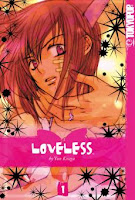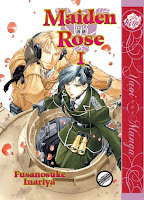My News and Reviews
Probably the most important thing to take away from Experiments in Manga last week is the fact that I will be hosting January’s Manga Moveable Feast! This month, from January 20 through January 26, we will be focusing on the work of Moyoco Anno. I’d love to have as many people contribute to the Feast as possible, so please do check out the Call for Participation and the Archive.
Also announced at Experiments in Manga last week was the Shoujo Science Fiction giveaway winner. The post also includes a list of shoujo manga with science fiction elements that have been licensed in English. I revealed the ridiculous amounts of manga and anime I managed to acquire last month in December 2012’s Bookshelf Overload. Finally, I posted the first in-depth manga review of 2013! The honor goes to Ryo Hanada’s Good-bye Geist from Gen Manga. Even though some of the storytelling is a little awkward, I’m actually quite fond of Good-bye Geist as a whole.
Robot 6 posted quite a few previews and exclusives over this past week, including Shigeru Mizuki’s Kitaro from Drawn and Quarterly (which I’m looking forward to and already have preordered), Inio Asano’s Nijigahara Holograph from Fantagraphics (which looks amazing; I’ll definitely be ordering it), and the Western comics adaptation of Cyborg 009 from Archaia (which could either be great or go horribly wrong).
Elsewhere online, Noah Berlatsky of The Hooded Utilitarian wrote a great article on Moto Hagio’s The Heart of Thomas for The Atlantic—The Gay Teen-Boy Romance Comic Beloved by Women in Japan (Noah didn’t get to choose the article title). This led me back to an article I had forgotten about at The Hooded Utilitatraoin from a few years ago by J. R. Brown—1000 Years of Pretty Boys. Last week’s Jason Thompson’s House of 1000 Manga was particularly interesting, looking at The Greatest Manga Censorship Fails. Finally, I was recently reminded that The Golden Ani-Versary of Anime project has started. A group of anime bloggers are tackling anime’s timeline and devoting at least one post to each year beginning with 1963.
Quick Takes
 Bad Teacher’s Equation, Volume 1 by Kazuma Kodaka. After reading the first volume of Bad Teacher’s Equation, I’m not entirely convinced that Kodaka knew what she was doing with the series at first. It also feels a bit dated, but that’s not necessarily a bad thing. Bad Teacher’s Equation is boys’ love with shounen influences. There’s a lot going on that doesn’t quite mesh yet—delinquents, basketball, car chases, cross-dressers, host/ess clubs, fujoshi, awkward relationships, etc. But despite it’s random goofiness, or maybe because of it, I actually really enjoyed the first volume of Bad Teacher’s Equation. I’ve heard that the manga gets much better from here, so I’ll definitely be checking out more of the series.
Bad Teacher’s Equation, Volume 1 by Kazuma Kodaka. After reading the first volume of Bad Teacher’s Equation, I’m not entirely convinced that Kodaka knew what she was doing with the series at first. It also feels a bit dated, but that’s not necessarily a bad thing. Bad Teacher’s Equation is boys’ love with shounen influences. There’s a lot going on that doesn’t quite mesh yet—delinquents, basketball, car chases, cross-dressers, host/ess clubs, fujoshi, awkward relationships, etc. But despite it’s random goofiness, or maybe because of it, I actually really enjoyed the first volume of Bad Teacher’s Equation. I’ve heard that the manga gets much better from here, so I’ll definitely be checking out more of the series.
 GTO: 14 Days in Shonan, Volumes 1-4 by Tohru Fujisawa. It’s been a few years since I read Fujisawa’s original Great Teacher Onizuka manga, but I do remember enjoying it. Fujisawa isn’t really doing anything new or different with 14 Days in Shonan. The artwork might be a bit more polished and the supporting characters and location have changed, but Onizuka is still Onizuka. There are plenty of other parallels to the original series, too. 14 Days in Shonan takes place in the middle of Great Teacher Onizuka, during the summer vacation after Onizuka was shot by fellow teacher Teshigawara. 14 Days in Shonan is fairly easy to jump into even if you haven’t read the original manga. The story and characters are still outrageous, over-the-top, and highly entertaining.
GTO: 14 Days in Shonan, Volumes 1-4 by Tohru Fujisawa. It’s been a few years since I read Fujisawa’s original Great Teacher Onizuka manga, but I do remember enjoying it. Fujisawa isn’t really doing anything new or different with 14 Days in Shonan. The artwork might be a bit more polished and the supporting characters and location have changed, but Onizuka is still Onizuka. There are plenty of other parallels to the original series, too. 14 Days in Shonan takes place in the middle of Great Teacher Onizuka, during the summer vacation after Onizuka was shot by fellow teacher Teshigawara. 14 Days in Shonan is fairly easy to jump into even if you haven’t read the original manga. The story and characters are still outrageous, over-the-top, and highly entertaining.
 Please Save My Earth, Volumes 8-14 by Saki Hiwatari. I am still loving this series. These few volumes spend quite a bit of time delving into Shion’s backstory. He’s an extremely tragic character. His past has twisted him so much as a person that, while it is easy to feel sympathy for him, it’s difficult to actually like him. As fascinating as Rin and the rest of the characters’ past live are, it’s how they are dealing with those memories and leftover feelings in their current lives that I find particularly engaging. Their past lives are causing more and more trouble for them. The story of Please Save My Earth has become increasingly complicated and involved; I’m very curious to see how Hiwatari will bring things to a close.
Please Save My Earth, Volumes 8-14 by Saki Hiwatari. I am still loving this series. These few volumes spend quite a bit of time delving into Shion’s backstory. He’s an extremely tragic character. His past has twisted him so much as a person that, while it is easy to feel sympathy for him, it’s difficult to actually like him. As fascinating as Rin and the rest of the characters’ past live are, it’s how they are dealing with those memories and leftover feelings in their current lives that I find particularly engaging. Their past lives are causing more and more trouble for them. The story of Please Save My Earth has become increasingly complicated and involved; I’m very curious to see how Hiwatari will bring things to a close.
 Uzomuzo edited by Adam Pasion. Uzomuzo is a comics collective based in Nagoya, Japan made up of a group of international creators. The Uzomuzo book came about as a result of a Kickstarter project. Included in the collection are twelve hour comics, short stories, jam comics, and Kickstarter commissions. Most of the book is in English, but there is some untranslated Japanese as well. The contributors to Uzomuzo originally hail from the United States, the United Kingdom, and Japan. Uzomuzo is an interesting and somewhat curious collection of alternative and experimental comics and manga. I was particularly intrigued by the improvisational jam comics in which a different artist was responsible for each panel, riffing off of whatever came before.
Uzomuzo edited by Adam Pasion. Uzomuzo is a comics collective based in Nagoya, Japan made up of a group of international creators. The Uzomuzo book came about as a result of a Kickstarter project. Included in the collection are twelve hour comics, short stories, jam comics, and Kickstarter commissions. Most of the book is in English, but there is some untranslated Japanese as well. The contributors to Uzomuzo originally hail from the United States, the United Kingdom, and Japan. Uzomuzo is an interesting and somewhat curious collection of alternative and experimental comics and manga. I was particularly intrigued by the improvisational jam comics in which a different artist was responsible for each panel, riffing off of whatever came before.
King of Thorn directed by Kazuyoshi Katayama. Although I quite enjoyed Yuji Iwahara’s King of Thorn manga series, I do remember it being somewhat convoluted. The animated film adaptation is no less bewildering. In fact, it may even be more so. The film and the manga start out very similarly, but by the end they’ve gone in different directions. The pacing of the film seemed a little awkward. In the beginning, it’s almost tortuously slow, so the ending ends up having to be rushed in order to fit all of the plot twists in. Ultimately, I wasn’t always entirely sure what was going on, but there were some nice action sequences and the animation was pretty good, too. I do prefer the manga, though.












